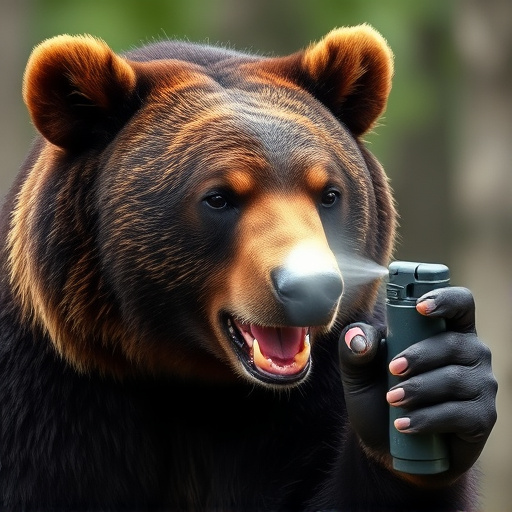Bear spray, a vital tool for navigating bear country, uses capsaicin to disable bears within a 30-foot range, crucial for safety during encounters. The Bear Spray Fog Pattern Test assesses the effectiveness of holsters, ensuring swift deployment and dense fog coverage at close range, key features for effective bear deterrence. This test is a critical metric in evaluating bear spray holsters, providing insights into design impact on quick access and optimal fog pattern for user protection.
In bear country, quick access to bear spray can be a matter of life and death. Understanding the effectiveness of bear spray and prioritizing quick draw access during emergencies is crucial for hikers and outdoor enthusiasts. This article explores these key aspects through a comprehensive review of bear spray fog pattern tests, alongside an evaluation of holster design for optimal performance. Learn how to make informed choices to enhance your safety in potentially dangerous encounters.
- Understanding Bear Spray and its Effectiveness
- The Importance of Quick Draw Access in Emergency Situations
- Evaluating Holster Design for Optimal Performance
- Testing the Bear Spray Fog Pattern: A Comprehensive Review
Understanding Bear Spray and its Effectiveness
Bear spray, also known as bear deterrent or bear repellent, is a crucial tool for anyone venturing into bear country. It’s designed to create a barrier between you and an aggressive bear, temporarily blinding and disorienting the animal with a fine mist of capsaicin, the active ingredient found in chili peppers. The effectiveness of bear spray lies in its ability to disrupt the bear’s behavior patterns. When used correctly, it creates a fog pattern that can reach up to 30 feet (9 meters), providing an escape route and time to retreat from potentially dangerous encounters.
The Bear Spray Fog Pattern Test is a measure of how far the spray can travel and still be effective. This test reveals the optimal range for quick draw access, ensuring that users can deploy the spray effectively when bears are within close proximity. Understanding the spray’s fog pattern helps individuals make informed decisions about their safety in bear habitats, promoting responsible outdoor activities while minimizing potential conflicts with these majestic creatures.
The Importance of Quick Draw Access in Emergency Situations
In emergency situations, every second counts, especially when facing potentially dangerous wildlife like bears. The ability to quickly access bear spray from a holster can mean the difference between a manageable encounter and a life-threatening one. A successful defense against an aggressive bear depends on the efficiency of deploying protective gear, which is why quick draw access is so crucial.
The Bear Spray Fog Pattern Test is a great example of how manufacturers assess and certify holsters for swift deployment. This test simulates real-world scenarios, ensuring that users can reliably retrieve their spray in high-pressure moments. By prioritizing quick draw access, individuals in bear country gain a vital advantage, enhancing their safety during unexpected encounters with these majestic yet potentially dangerous creatures.
Evaluating Holster Design for Optimal Performance
When evaluating a bear spray holster, one key aspect is understanding how it performs during quick-draw access. The design should allow for swift and precise deployment of the spray can, which is crucial in potentially dangerous wildlife encounters. Many holsters incorporate various features to enhance this functionality. For instance, some models feature spring-loaded mechanisms or ergonomic grips that facilitate a faster grip and draw, enabling users to react promptly when faced with an aggressive bear.
The Bear Spray Fog Pattern Test is a useful metric for gauging the effectiveness of these designs. This test assesses how consistently and widely the spray pattern covers an intended target. A well-designed holster should ensure that the spray can be fired in such a way that it creates a dense fog, providing maximum protection against bears. This test reveals whether certain holsters’ designs enable a user to effectively defend themselves by delivering a powerful, broad fog pattern at close range.
Testing the Bear Spray Fog Pattern: A Comprehensive Review
When evaluating bear spray holsters, one crucial aspect to consider is the effectiveness of the bear spray fog pattern. A comprehensive Bear Spray Fog Pattern Test reveals the real-world performance of the spray distribution. These tests simulate various scenarios, from close encounters to long-range shots, to assess the spray’s range, intensity, and consistency.
The results of such tests offer valuable insights into how well a holster design enables quick draw access while ensuring optimal fog pattern coverage. This is essential for users’ safety, as an even and wide fog pattern increases the chances of deterring bears effectively during encounters.
In evaluating bear spray holsters, focusing on quick draw access and the bear spray fog pattern test is paramount. Understanding the effectiveness of bear spray and optimizing holster design ensures preparedness in emergency situations where every second counts. The comprehensive review highlights the importance of choosing a holster that facilitates rapid deployment of bear spray, ultimately contributing to personal safety in bear country.
